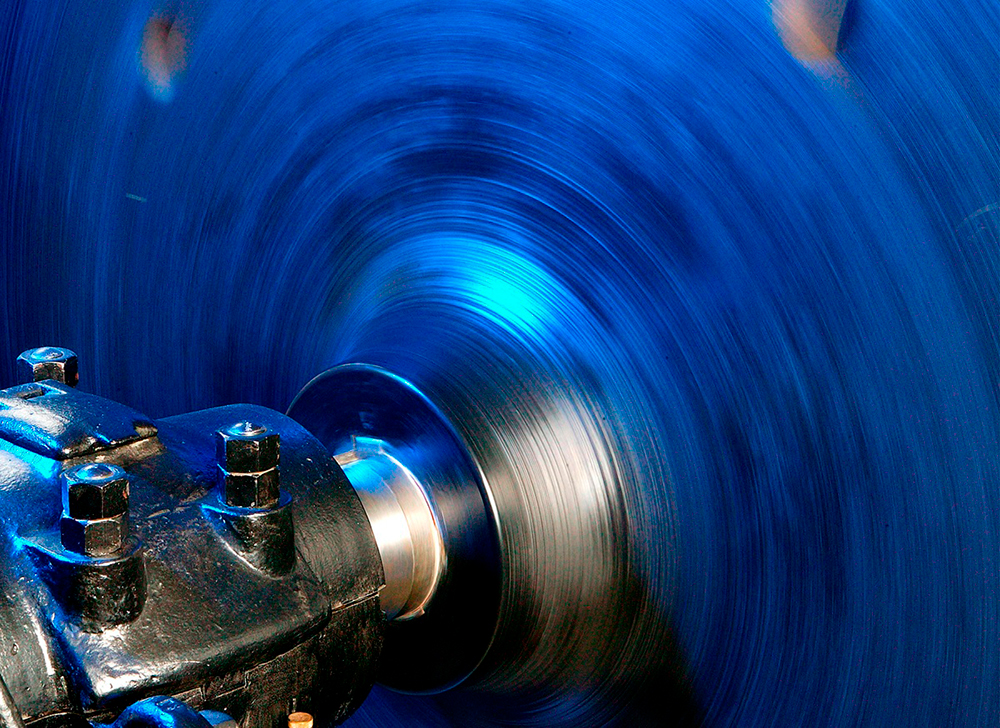The Challenge: How do we create better storage for renewable energy?
The Research: Adapt a centuries-old technology to meet today's energy storage needs
The Players: Graduate students Miles Skinner, '17 MSc, and Balakrishnan Nagarajan, working under Pierre Mertiny, '05 PhD, and Ahmed Qureshi, professors of mechanical engineering
Energy is all around us - it can be harvested from sources such as wind, sun and moving water - but it's still difficult to store effectively. Working under the supervision of Pierre Mertiny, researchers are chipping away at the challenges and high costs of energy storage. One possibility is the new use of an old technology: the flywheel.
You know, almost intuitively, how the mechanical energy storage system called a flywheel works. Think of a foot-operated sewing machine or a spinning top. Both collect and store kinetic energy in the flywheel, and release it when needed, typically over a short time.
Mertiny's team is using flywheel technology to build a mechanical battery that stores surplus energy from any source to ensure it's available for high demand or acute energy needs, such as during peak electrical consumption or sudden power outages.
Flywheels are energy dense, meaning they're ready to supply power in quick bursts to deal with those spikes in use. "Flywheels are good at providing high power - a lot of energy in a short time," says grad student Miles Skinner. They are also great in low temperatures, a limiting factor for chemical batteries, as anyone trying to use a smartphone outdoors in winter can attest. Plus, chemical batteries can contain materials that are hazardous to the environment.
A body in motion will stay in motion unless something is acting on it to slow it down. In a flywheel that something is friction, which reduces the kinetic energy storage and results in energy loss. The team has worked to address the friction problem, including designing a vacuum enclosure and employing low friction bearings to limit losses. Skinner is working on a different aspect of this problem: the buildup of force.
The flywheels that the team is working on rotate fast, around 20,000 to 40,000 revolutions per minute in some prototypes. "An electrical engineer might be concerned with how to add or take out energy," Skinner says. As a mechanical engineer, he explains his concern is with the force that builds up in the rotating flywheel. "The forces are enormous. It can tear itself apart," he says. He is studying the behaviour of flywheels over their service life - stress and strain buildup in a flywheel - and how to use the information to improve the next generation of flywheel energy storage systems.
Flywheels are already in use in some European trains, where they collect, store and release kinetic energy from the vehicles' braking systems. Another big potential application for a flywheel is in energy utility grids.
Utility companies can use stored kinetic energy as a buffer, stabilizing the frequency of their grid, mitigating power fluctuations, blackouts and spikes in demand. While only certain parts of current flywheel systems are recyclable, Skinner believes that challenge can be overcome. In the meantime, they have an exceptionally long life, 20-plus years, he says.
Mertiny's group, which started in 2006, is making prototype energy-storing flywheels. Their next challenges include extending energy storage time from minutes, which would be useful when operating a train or a bus, to hours or days, which would be useful in energy grids. And they need to make it cost effective. The team did some initial work to design flywheels for residential solar installations to collect solar energy and store it to power homes through times the sun isn't out or when the home is hungry for more energy that the installation can give.
The winning formula will come from interactions among multiple energy sources and the ways we integrate the new ones into our energy infrastructure. The magic of how we power ourselves in the future is at this point of interplay.
"Energy storage and generation will be multi-faceted," Skinner predicts. "We have to ask how can we maximize the benefits to get the most of various sources. No single one is the best, but all of them will have their place."
-with files from Rich Cairney

We at New Trail welcome your comments. Robust debate and criticism are encouraged, provided it is respectful. We reserve the right to reject comments, images or links that attack ethnicity, nationality, religion, gender or sexual orientation; that include offensive language, threats, spam; are fraudulent or defamatory; infringe on copyright or trademarks; and that just generally aren’t very nice. Discussion is monitored and violation of these guidelines will result in comments being disabled.